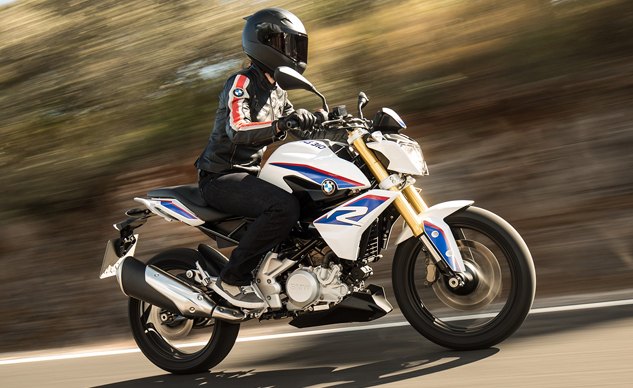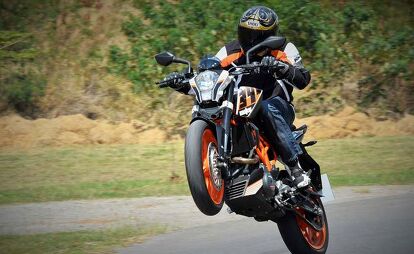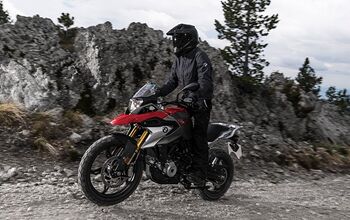The BMW G310R Versus The World

How does BMW's new little bike stack up to its competitors?
With BMW’s announcement that it will be producing a small-displacement, single-cylinder motorcycle – the G310R – aimed at newer riders and available come the latter stages of 2016, the German marque has signaled to everyone that it’s aiming at world domination. And if you’re familiar with South Park or internet memes, I’m imagining the plan goes a little something like this:
Step one: Lure new riders with the G310R.
Step two: After a while, move them up to the G650, F700, or F800 models.
Step three: Move them up again to the RnineT, R1200 or S1000 line.
Step four: Finish them off with the K1600 series.
Step five: ???
Step six: Profit!
Ok, so that was clearly an attempt at humor. On paper anyway, BMW seems to have a formidable small-displacement motorcycle on its hands with the G310R. The problem it faces is a stacked field of competitors from Austria and Japan in the form of the KTM 390 Duke, Suzuki GW250Z, a pair of Hondas – the CB300F and CB500F – and the not-yet-announced-for-America-but-probably-will-be-soon Kawasaki Z300 and Yamaha MT-03 (likely to be called the FZ-03 if/when it comes here). The irony here, of course, is that none of these machines are manufactured in their OEM’s home country, as global economics dictate these motorcycles be produced in up-and-coming markets – India, Thailand, China, and Indonesia in this case.
So, with the small-displacement, entry-level category heating up, let’s take a look at all seven of these models to see how the BMW stacks up. Here we’ve gathered the relevant specs to draw some conclusions. Pricing has yet to be announced for the BMW (and the Kawasaki and Yamaha have yet to even be announced for America), but save for the CB500F, the sweet spot in this market is between $4000 – $5000. Expect the G310R to slot in near the KTM at $4,999.
The S1000R-inspired G310R’s 313cc Single features two camshafts and four valves, but its distinctive feature is its slightly rearward canted cylinder and reverse-mounted cylinder head, placing the air intake towards the front of the motorcycle while the exhaust exits from the rear of the cylinder head, giving the header a more direct route towards the silencer.
BMW claims 34 peak horsepower at 9,500 rpm and 21 lb-ft. at 7,500 rpm. When compared to the G310R’s closest likely rival, the KTM 390 Duke, the BMW falls slightly behind due to 60cc less displacement. Using the power numbers we obtained with the 390 Duke’s close sibling, the RC390, we get 39.7 horses at 8,900 rpm and 24.6 lb-ft. at 7,000 rpm. At a claimed wet weight of 345 lbs., the Duke also has a 4-lb. weight advantage over the G3.
That said, the two European brands have a leg up on the other five bikes here. Assuming power outputs for the Z300 and MT-03 are similar to their fully-faired counterparts, the Ninja 300 (34.6 hp, 17.6 lb-ft.) and YZF-R3 (35.3 hp, 18.9 lb-ft.), respectively, the two Japanese twin-cylinders lack the torque of the BMW and KTM Singles and carry a nearly 30-lb. weight penalty, both bikes claimed at 370 lbs. For comparison, the Ninja 300 tipped the MO scales at 381 lbs., the R3 at 370 lbs. Thirty pounds is a big burden to carry, especially when you’re asking less than 40 horses to do it.
Unsurprisingly, the CB500F Honda, with the largest displacement of the group, produces more power and torque (43.0 hp, 29.1 lb-ft.) than the rest, but not by much. It’s also the heaviest model here at 418 lbs. The 286cc CB300F Single puts up a respectable 26.2 hp and 17.4 lb-ft, and weighs in at 351 lbs., while the Suzuki brings up the rear with 19.2 hp, 13.7 lb-ft., and a 407-lb. curb weight. At 248cc, the Suzuki has the smallest displacement here and is also the only one with single overhead cam. It should also be noted that the Suzuki is listed as a 2015 model and is not listed under Suzuki’s 2016 lineup.
As budget-minded motorcycles intended for new or newish riders, none of the seven models come with sophisticated suspension, though the BMW and KTM again stand out from the crowd with inverted forks. Both add a certain element of sophistication and class to their respective models despite the overall low price point. Only the CB500F offers fork spring preload adjustability. Rear suspension is similarly basic, each offering a single shock only adjustable for spring preload. That said, in our time with the Duke, CB300/500, Ninja 300, and R3, all are capable of ripping up a canyon road at a rather respectable pace while still providing a decent ride everywhere else. There’s no reason not to expect similar handling from the BMW.
With its 25.1º rake and 4.0 inches of trail, the G310R’s geometry is similar to the rest. The KTM, again, has a slightly sharper rake, 25.0º, but so does the MT-03. The Suzuki and Kawasaki have the laziest rake angles, 26.0º, but the Z300 has the least amount of trail, 3.2 in. Compared to the Ninja 300’s 27º rake and 3.7-inch trail numbers, that’s a rather steep difference. The BMW has the second-shortest wheelbase at 54.1-inches (bested only by the Duke’s 53.8 inches), so it should be poised to keep pace with the pack-leading KTM come the tight stuff. All seven bikes ride on 17-inch wheels, and all but the CB500 use 110mm-wide front tires. The KTM and BMW use slightly fatter rear tires (150 vs. 140) than the Japanese roadsters, save for the CB500’s 160.
Like the rest of the BMW model range, the G310R will come standard with ABS, a major plus in our opinion. The KTM has such a feature as standard equipment, as do the Z300 and MT-03. All seven models rely on a single disc at either end, with the BMW’s front measuring 300mm. It’s clamped by a radial-mount four-piston caliper with gold anodizing. Steel-braided lines are also standard. Those are trick features for any bike, matched only by the KTM in this crowd, though the Austrian skips the gold anodization. The Japanese models feature single front discs ranging in size from 290mm to 320mm and are all clamped by twin-piston calipers.
In our experience, we’ve been disappointed with the KTM’s braking, favoring the braking power of the Japanese models instead. Our suspicion is a simple brake pad swap is all that’s needed to bring the KTM in line with the others. On paper anyway, the BMW should be among the best in this group when it comes to shedding speed.
When talking about bikes aimed at newer riders, seat height is an important topic. At 30.9 inches, the G310R is within 0.2-inch of all the others except the 390 Duke and its 31.5-inch saddle. Should that be too high or too low, BMW has also made available accessory seats that either lower the seat height to 29.9 inches for shorties, or 32.0 inches for taller folk.
Fully digital LCD gauge clusters provide the BMW, KTM and Honda riders with information, while the Suzuki, Kawasaki and Yamaha all feature an analog rev counter. Gear-position indicators on the BMW, KTM, Suzuki, and Yamaha get bonus points, especially for the price category these bikes reside in.
In the end, there’s no reason to believe the BMW G310R won’t have what it takes to claim the crown among the small-displacement naked-bike field. Just look what it did in the liter-class sportbike category. It observed the field and made an astounding (and arguably better) product at a competitive price. BMW appears to be following the same formula at the other end of the spectrum, with the competition equally as fierce at this end of the field.
Of course, comparing specs on paper can only tell you so much. We’re looking forward to testing the BMW G310R against its rivals. Here’s hoping the Kawasaki Z300 and Yamaha MT-03 are able to join the party. Hover over the image below to see the complete spec chart for each bike.

Troy's been riding motorcycles and writing about them since 2006, getting his start at Rider Magazine. From there, he moved to Sport Rider Magazine before finally landing at Motorcycle.com in 2011. A lifelong gearhead who didn't fully immerse himself in motorcycles until his teenage years, Troy's interests have always been in technology, performance, and going fast. Naturally, racing was the perfect avenue to combine all three. Troy has been racing nearly as long as he's been riding and has competed at the AMA national level. He's also won multiple club races throughout the country, culminating in a Utah Sport Bike Association championship in 2011. He has been invited as a guest instructor for the Yamaha Champions Riding School, and when he's not out riding, he's either wrenching on bikes or watching MotoGP.
More by Troy Siahaan
































































Comments
Join the conversation
Good for BMW. It only makes the biking experience better for everyone. All these bikes are freeway doable. ABS, proper horse power, brakes, and suspension should be a given. I have a 1200R, but my daughter keeps talking about getting one, all these bikes will get a look see.
After the design and manufacturing of the bike, the dealer is the weakest, or strongest, link in the motorcycle sales and service chain. I was recently advised of a recall on my Yamaha FJ09 and called three dealers for help. I live in the boonies, and thirty-five miles from the nearest dealership. Without even checking to see if I had purchased the bike from them, two of the three said I would need to ride my bike to them, leave it for two to three weeks, and navigate a trip home and then back to pick it up when done. My favorite dealer, Simi Valley Cycles, in California, didn't drop a beat, and emailed me a work order, I signed and scanned and attached the recall letter to my email and sent it back. They ordered the parts sight unseen, and will tell me when the part comes in and I ride down and have it done while I wait. Now that is what I can call just ordinary service but is way above and beyond what I found elsewhere; kudos to them for their approach. I have purchased five bikes from them and will gladly do another when the FJ10 emerges.
BTW, I have had a similar experience with my local Ducati dealer, who responds to emails, gives me estimates back via email, and takes really good care of me. I know that some have had other opinions and experiences, but I for one also like Ducati of Santa Barbara. If there is a problem, they work with me on it, and the BS about Ducati taking you to the cleaners on service they have proven wrong.
The dealer is the weakest link in the supply chain. The lack of service is what kills me. That comes for sales and after-sales service. So easy to do right, and so many do it so wrong. If they all could behave like they cared about the customer and were willing to treat you with kindness and respect, there would be more bikes on the road.